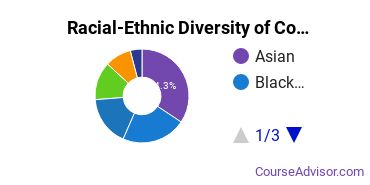Computer & Information Sciences at Rutgers University - Newark
Rutgers Newark is located in Newark, New Jersey and approximately 13,231 students attend the school each year.
Want to know more about the career opportunities in this field? Check out the Careers in Computer & Information Sciences section at the bottom of this page.
Rutgers Newark Computer & Information Sciences Degrees Available
- Bachelor’s Degree in Computer & Information Sciences
- Master’s Degree in Computer & Information Sciences
Rutgers Newark Computer & Information Sciences Rankings
The computer & information sciences major at Rutgers Newark is not ranked on College Factual’s Best Colleges and Universities for Computer & Information Sciences. This could be for a number of reasons, such as not having enough data on the major or school to make an accurate assessment of its quality.
Computer & Information Sciences Student Demographics at Rutgers Newark
Take a look at the following statistics related to the make-up of the computer & information sciences majors at Rutgers University - Newark.
Rutgers Newark Computer & Information Sciences Bachelor’s Program

Prospective students may be interested in knowing that this school graduates 43% more racial-ethnic minorities in its computer & information sciences bachelor's program than the national average.*
The following table and chart show the race/ethnicity for students who recently graduated from Rutgers University - Newark with a bachelor's in computer & information sciences.

| Race/Ethnicity | Number of Students |
|---|---|
| Asian | 25 |
| Black or African American | 15 |
| Hispanic or Latino | 25 |
| White | 14 |
| International Students | 1 |
| Other Races/Ethnicities | 6 |
Rutgers Newark Computer & Information Sciences Master’s Program

The following table and chart show the race/ethnicity for students who recently graduated from Rutgers University - Newark with a master's in computer & information sciences.

| Race/Ethnicity | Number of Students |
|---|---|
| Asian | 14 |
| Black or African American | 1 |
| Hispanic or Latino | 2 |
| White | 2 |
| International Students | 89 |
| Other Races/Ethnicities | 1 |
Concentrations Within Computer & Information Sciences
Computer & Information Sciences majors may want to concentrate their studies in one of these areas. The table shows all degrees awarded in this field awarded for all degree levels at Rutgers University - Newark. A concentration may not be available for your level.
| Concentration | Annual Degrees Awarded |
|---|---|
| Computer Information Systems | 265 |
| Information Science | 24 |
Related Majors
Careers That Computer & Information Sciences Grads May Go Into
A degree in computer & information sciences can lead to the following careers. Since job numbers and average salaries can vary by geographic location, we have only included the numbers for NJ, the home state for Rutgers University - Newark.
| Occupation | Jobs in NJ | Average Salary in NJ |
|---|---|---|
| Software Applications Developers | 46,930 | $107,640 |
| Managers | 18,370 | $138,820 |
| Computer and Information Systems Managers | 14,280 | $176,690 |
| Computer User Support Specialists | 13,910 | $65,260 |
| Computer Systems Analysts | 13,710 | $107,540 |
References
*The racial-ethnic minorities count is calculated by taking the total number of students and subtracting white students, international students, and students whose race/ethnicity was unknown. This number is then divided by the total number of students at the school to obtain the racial-ethnic minorities percentage.
More about our data sources and methodologies.
